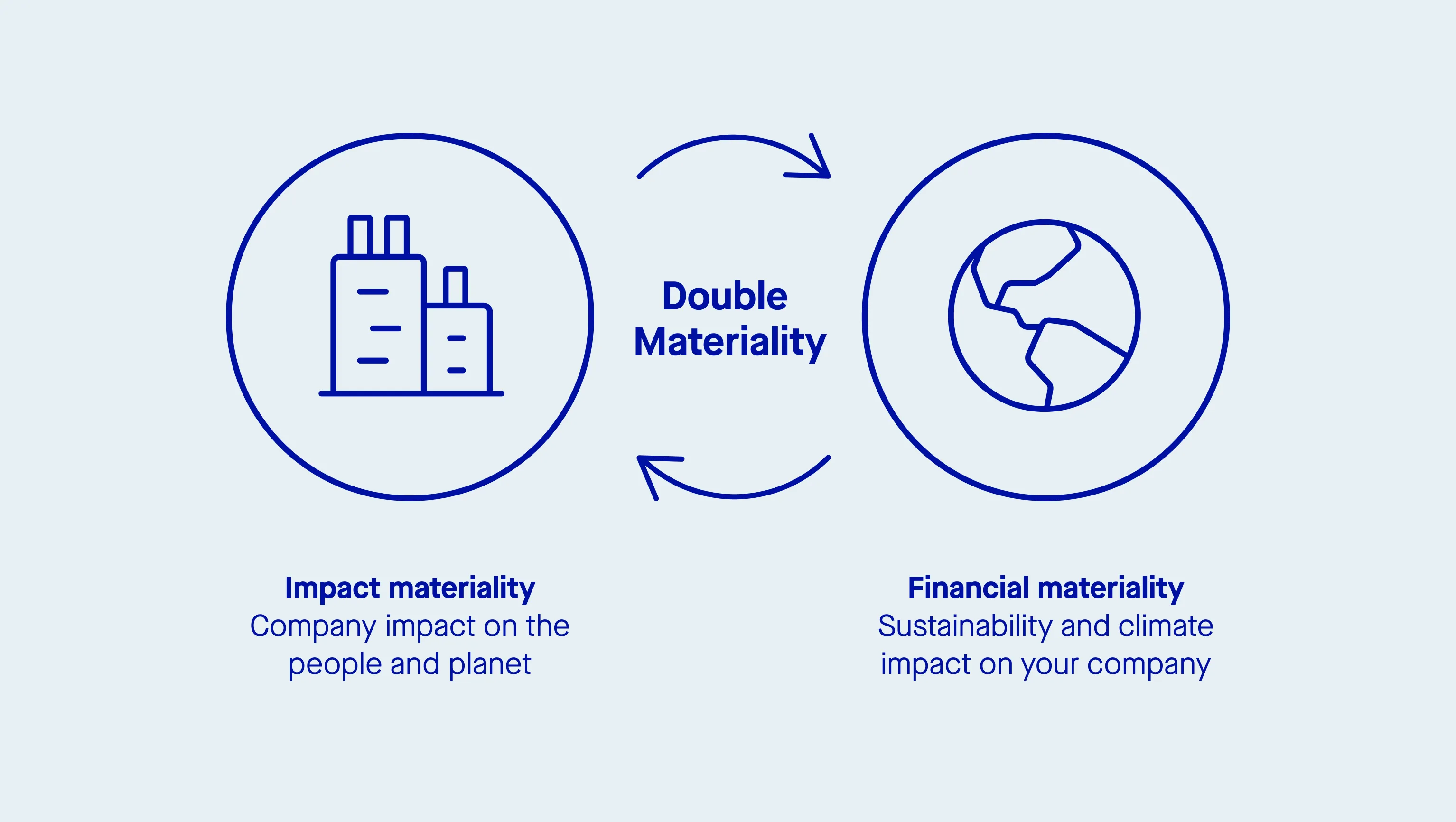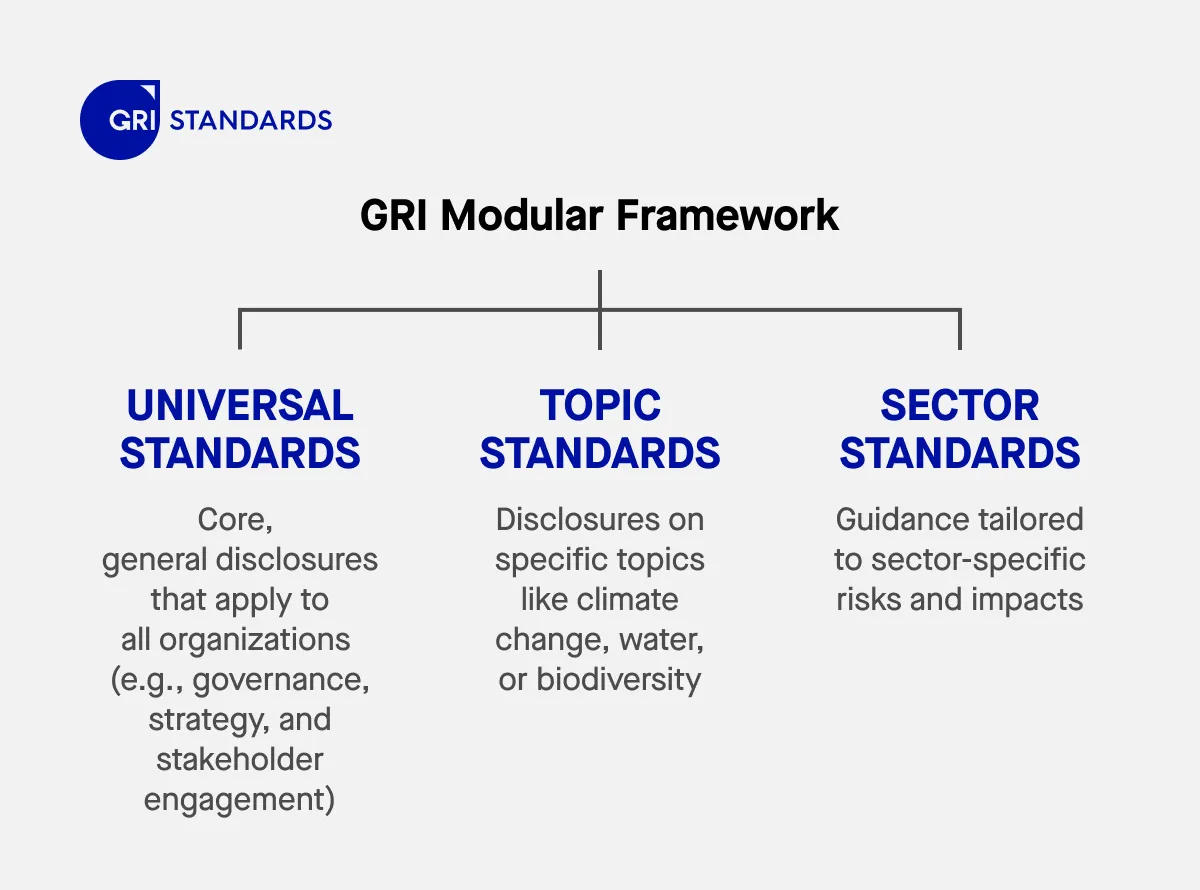Why should businesses prioritize GRI reporting?
GRI reporting offers significant strategic advantages for organizations committed to sustainability leadership. According to KPMG’s Survey of Sustainability Reporting, 96% of the world’s largest 250 companies now publish sustainability reports, with GRI Standards being the most commonly used framework globally.
The benefits of implementing GRI reporting extend beyond compliance:
- Enhanced stakeholder trust: Transparent reporting builds credibility with investors, customers, and regulatory bodies
- Improved risk management: Systematic assessment of sustainability impacts helps identify and mitigate potential risks
- Competitive advantage: Comprehensive ESG disclosure increasingly influences investment decisions and customer preferences
- Operational efficiency: The reporting process often reveals opportunities for cost savings and process improvements
- Regulatory preparedness: GRI alignment helps organizations prepare for emerging mandatory disclosure requirements
How does GRI differ from ISSB and CSRD?
GRI focuses on an organization’s impact on people and the planet, while ISSB and CSRD emphasize financial relevance and regulatory compliance.
| Feature |
GRI |
ISSB |
CSRD |
| Materiality |
Double (impact-driven) |
Financial (investor-focused) |
Double (impact + financial) |
| Audience |
All stakeholders |
Investors |
Regulators, investors |
| Purpose |
Voluntary sustainability impact |
Global baseline for disclosures |
Mandatory EU ESG reporting |
| Scope |
Broad: environmental, social, economic |
Climate-first, expanding |
Aligns with GRI and ISSB |
The GRI framework is frequently used alongside other frameworks such as CDP, SASB, TCFD, and more, providing organizations with broad compatibility for ESG reporting. At the core of the GRI framework are the universal standards, which serve as a foundational and mandatory set of guidelines for all organizations, establishing a common language for sustainability disclosures across economic, social, and environmental topics.
Bottom line: GRI is best for impact-led reporting. ISSB and CSRD are key for meeting investor and regulatory demands.
Step 1: Conduct a comprehensive materiality assessment
The foundation of effective GRI reporting lies in identifying and prioritizing your organization’s most significant sustainability impacts through a robust materiality assessment. This process determines which topics deserve focus in your sustainability report and guides resource allocation for improvement initiatives. By conducting a materiality assessment, organizations can better understand and disclose their company’s impact on environmental, social, and economic dimensions.
Identify potential material topics
Begin by creating a comprehensive list of potential sustainability topics relevant to your organization. Consider:
- Industry-specific environmental impacts (emissions, water use, waste generation)
- Social considerations (labor practices, community relations, human rights)
- Economic factors (economic performance, procurement practices, anti-corruption)
- Governance elements (board diversity, executive compensation, risk management)
GRI also provides guidance for specific sectors, helping organizations in industries like oil and gas, agriculture, and mining identify the most relevant sustainability topics.
The materiality assessment should consider double materiality, addressing both the organization’s internal impacts and its external influence on society and the environment. It is important to identify a broad range of sustainability issues, including ESG impacts, economic impacts, environmental impact, and occupational health, to ensure comprehensive and transparent reporting.

Review GRI’s topic-specific standards, industry guidance, and peer reports to ensure comprehensive coverage. Engage internal teams across functions to capture diverse perspectives on potential impacts.
Assess impact significance
Evaluate each potential topic based on:
- Severity: How serious are the actual or potential negative impacts?
- Scope: How widespread are the impacts across your value chain?
- Likelihood: What is the probability of potential impacts occurring?
- Remediability: How difficult would it be to address negative impacts?
Use both quantitative data and qualitative assessments to score each topic. Consider both positive and negative impacts, including those occurring within your organization and throughout your value chain. It is important to identify and report on areas where your organization can have a positive impact, as well as mitigating negative impacts, to demonstrate your commitment to sustainability and social responsibility.
Prioritize stakeholder concerns
Identify key stakeholder groups including investors, customers, employees, communities, NGOs, and regulators. Gather input through:
- Stakeholder surveys and interviews
- Focus groups and workshops
- Review of stakeholder communications and feedback
- Analysis of media coverage and public discourse
The materiality assessment process should involve civil society, external stakeholders, and diverse stakeholders to ensure that a wide range of perspectives and concerns are addressed.
Map stakeholder concerns against your impact assessment to identify alignment and gaps. Topics that rank high on both impact significance and stakeholder concern should receive priority attention.
Step 2: Establish robust data collection and management systems
Effective GRI reporting requires systematic data collection processes that ensure accuracy, completeness, and consistency across reporting periods. Building these systems early in your reporting journey prevents data quality issues and supports continuous improvement efforts. Robust data management is critical for accurately measuring and improving sustainability performance.
Design data collection frameworks
Create standardized templates and procedures for each material topic, specifying:
- Required data points and metrics
- Data sources and collection methods
- Responsible parties and approval processes
- Quality assurance checks and validation procedures
- Documentation requirements for audit trails
Data collection should be aligned with GRI’s reporting criteria and sustainability reporting requirements to ensure compliance, comparability, and transparency across organizations. Align data collection with GRI disclosure requirements while considering additional metrics that provide valuable context for stakeholders. Ensure consistency with existing management systems and reporting processes where possible.
Implement technology solutions
Modern sustainability reporting benefits significantly from dedicated technology platforms that:
- Automate data collection from multiple sources
- Provide real-time visibility into performance metrics
- Enable collaboration across teams and locations
- Support data validation and quality control
- Generate reports and visualizations for stakeholders
Carbon management tools like those offered by Sweep can significantly streamline data collection for environmental metrics, providing automated calculations and ensuring compliance with reporting standards.
Establish governance processes
Create clear governance structures that define:
- Roles and responsibilities for data collection and reporting
- Review and approval processes for reported information
- Escalation procedures for data quality issues
- Regular system updates and maintenance schedules
- Training programs for data collectors and reviewers
Strong governance ensures data integrity while building internal capacity for continuous improvement in reporting practices.
Step 3: Develop comprehensive disclosures aligned with GRI Standards
Once you’ve identified material topics and established data collection systems, the next step involves creating detailed disclosures that meet GRI Standards requirements while providing meaningful information to stakeholders. GRI reports are structured according to the GRI Universal Standards, which provide the foundation for all disclosures. In addition, sector and topic standards offer further guidance for specific industries and material issues, ensuring that social impacts are reported alongside environmental and economic impacts.

When developing disclosures, topic standards list the required disclosures for each material topic, helping organizations address relevant environmental, social, and governance issues in their GRI reports.
Structure your disclosures
Organize your sustainability report using GRI’s recommended structure:
- General disclosures: Provide context about your organization, strategy, and governance
- Material topic disclosures: Address each material topic with management approach and topic-specific disclosures
- Additional context: Include forward-looking information and explanations of performance trends
When applicable, organizations should refer to GRI sector standards, especially for industries with high environmental impact, to ensure sector-specific sustainability reporting. It is also important to disclose information related to environmental impact and climate change as part of comprehensive sustainability reporting.
Ensure each disclosure includes sufficient detail for stakeholders to understand your organization’s impacts and management approaches. Use clear, accessible language while maintaining technical accuracy.
Apply the management approach
For each material topic, describe your management approach including:
- Explanation of why the topic is material
- Policies and commitments related to the topic
- Goals, targets, and performance indicators
- Resources allocated to managing the topic
- Evaluation mechanisms and continuous improvement processes
Align your sustainability disclosures with the United Nations Sustainable Development Goals and consider the support of initiatives like the United Nations Environment Programme, which collaborates with GRI to advance global sustainability reporting standards.
The management approach provides context that helps stakeholders understand how your organization addresses its most significant impacts.
Balance quantitative data with qualitative explanations that provide context and demonstrate understanding of your impacts. Where data is unavailable or estimated, clearly explain limitations and improvement plans.
Consider including:
- Multi-year trend data to show progress over time
- Benchmarking against industry peers or standards
- Case studies illustrating successful initiatives
- Challenges faced and lessons learned
- Future commitments and improvement plans
Step 4: Engage stakeholders throughout the reporting process
Stakeholder engagement is fundamental to GRI reporting, ensuring that your report addresses the information needs of key audiences while building relationships that support your sustainability objectives. Engaging stakeholders also helps organizations align their reporting with broader sustainability goals and commitments.
Plan engagement activities
Develop a stakeholder engagement strategy that considers:
- Key stakeholder groups and their information needs
- Appropriate engagement methods for each group
- Timing of engagement activities throughout the reporting cycle
- Resources required for meaningful engagement
- Integration with broader stakeholder engagement efforts
Stakeholder engagement should also include collaboration with other organizations, such as NGOs, industry groups, and governments, to broaden perspectives and foster best practices. Additionally, consider the information needs of capital markets, as their input is crucial for aligning with international sustainability reporting standards and meeting the expectations of investors and financial stakeholders.
Engagement should occur throughout the reporting process, not just at publication. Early engagement helps refine materiality assessments, while ongoing dialogue ensures reports remain relevant and useful.
Implement diverse engagement methods
Use various approaches to reach different stakeholder groups effectively:
- Digital platforms: Online surveys, webinars, and social media discussions
- Face-to-face interactions: Workshops, focus groups, and one-on-one meetings
- Written communications: Questionnaires, comment periods, and feedback forms
- Collaborative initiatives: Multi-stakeholder working groups and industry partnerships
Tailor engagement methods to stakeholder preferences and capabilities, ensuring accessibility and meaningful participation opportunities.
Incorporate feedback systematically
Establish processes to:
- Collect and analyze stakeholder feedback
- Identify common themes and priority concerns
- Integrate feedback into reporting content and processes
- Communicate back to stakeholders about how their input was used
- Track engagement effectiveness and continuous improvement
Document stakeholder feedback and your responses to demonstrate commitment to transparency and continuous improvement.
Step 5: Publish, communicate, and continuously improve your GRI report
The final step involves publishing your GRI report and using it as a foundation for ongoing stakeholder communication and internal improvement efforts. Multinational organizations benefit from GRI reports by ensuring consistent and comparable sustainability disclosures across regions, which enhances transparency and accountability.
Widespread adoption of GRI reporting also contributes to the development of environmentally responsible economies at both national and international levels, supporting sustainable development and responsible corporate practices.
Prepare for publication
Before publishing, ensure your report meets GRI Standards requirements through:
- Internal review processes involving senior management
- External assurance if required or desired
- Accessibility checks for diverse audiences
- Format optimization for different distribution channels
- Translation into relevant languages if needed
Consider publishing both comprehensive reports and executive summaries to serve different stakeholder needs and preferences.
Develop communication strategies
Create targeted communication plans for different stakeholder groups:
- Investors: Focus on financially material topics and long-term value creation
- Customers: Highlight product sustainability and supply chain practices
- Employees: Emphasize workplace practices and development opportunities
- Communities: Address local impacts and community investment
- Regulators: Demonstrate compliance and proactive risk management
Use multiple channels including websites, social media, presentations, and direct communications to maximize reach and engagement.
Establish continuous improvement processes
Use your GRI report as a foundation for ongoing improvement by:
- Setting performance targets based on reported baseline data
- Identifying gaps and improvement opportunities
- Benchmarking against industry peers and best practices; one example is using GRI Standards to compare your environmental impact disclosures with those of similar organizations, which helps ensure your reporting is done in a comparable manner
- Updating materiality assessments based on changing contexts
- Enhancing data collection and reporting systems
- Expanding stakeholder engagement efforts
Regular review and improvement ensure your reporting remains relevant and drives meaningful progress toward sustainability objectives.
Modern carbon management platforms significantly enhance GRI reporting capabilities by automating data collection, ensuring accuracy, and providing real-time insights into environmental performance. The GRI Standards are maintained and updated by the Global Sustainability Standards Board (GSSB), an independent body created by GRI to ensure the integrity and relevance of the standards.
These tools address common challenges in sustainability reporting while supporting strategic decision-making. GRI also collaborates with international initiatives such as the UN Global Compact to promote responsible business practices and global sustainability reporting.





